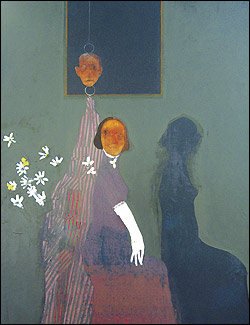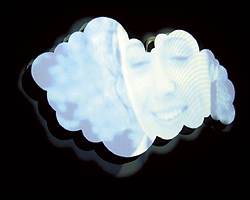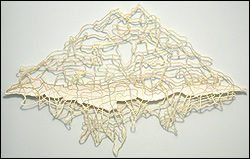Robert Marx
Now in his 70s, Robert Marx is a figurative painter and sculptor sui generis—if his work recalls any one artist, it’s probably Francis Bacon, another iconoclast who bucked aesthetic trends. But Marx has a softer edge than his British predecessor. Nearly every painting in this new series is a portrait of a woman—some in vaguely Victorian or Mennonite dresses, others young girls, all scratched onto the canvas with exquisitely fine brushwork. The pictures are loaded with an obscure array of symbols: rows of interlinked circles chained like a dainty network of cells, fingers that dissolve into flower petals, and the letter “M” serving as a mysterious talisman throughout. The decline of the body is a theme Marx returns to again and again: hands and heads are severed, figures are lit up under X-rays, wigs hover over chemotherapy baldness and fingers are splayed in a tense calm. If this all sounds a bit grim, it’s not—there’s a magnificent dignity to each of Marx’s intensely human figures. Marx’s bronzes are equally expressionist—the faces have a smooth but rugged sheen that recalls mummified icemen thawed out after thousands of years. In Confession the gray background of this vignette recalls a blank slate, a palimpsest upon which Marx masterfully explores the persistence of humanity through the struggles of life. Davidson Galleries, 313 Occidental Ave. S., 206-624-7684. 11 a.m.-5 p.m. Tues.-Sat.
Spain in the Age of Exploration
It’s tempting to draw parallels between Spain in the 17th century and the U.S. today—both innovators in the arts, sciences, and exploration, both global superpowers overextended and facing threats to their imperial ambitions. And there’s something very contemporary about the dark vision of artists like Velazquez, Zurbaran, and Goya that seems fitting to our age: the gothic, creepy, elongated forms of El Greco would feel right at home amid the brooding “pop surrealism” on the walls at Roq La Rue gallery. This week, SAM opens a huge show of art and artifacts documenting the cultural vibrancy of Spain’s golden age, including paintings, altarpieces, documents, navigational instruments, suits of armor, and other stuff of empire. Opening day includes a free lecture by curator Javier Morales of Spain’s Patrimonio Nacional museum. Seattle Art Museum, 100 University St., 206-654-3100. $12–$15. Opens Sat., Oct. 16. Ends Sun., Jan. 2.







